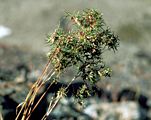Photoperiod may inhibit responses to warming
Adapted plants cannot easily be tricked by warmth at the wrong time. Plants use an internal calendar based on the day length/night length ratio which tells them when it is safe to sprout and flower. These plants are "photoperiod sensitive", they are controlled by photoperiodism.
Many plants will thus not be able to make any use of earlier snowmelt. They may in fact suffer (Keller and Körner 2003). For at least half of the high alpine flora, photoperiodism will constrain warming responses until new genotypes have evolved. Warming is thus likely to affect plant community composition.
Remember: Temperature is a dangerous signal for plant development. Most alpine plants go the "safe way" and control their development by photoperiod, their solar calendar.


